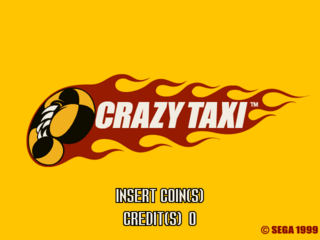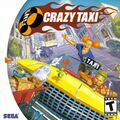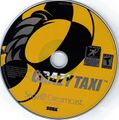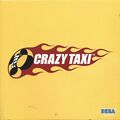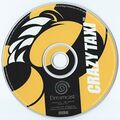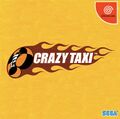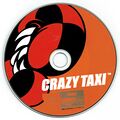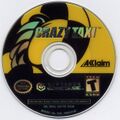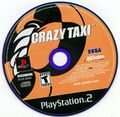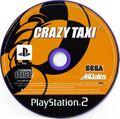Crazy Taxi
From Sega Retro
| Crazy Taxi |
|---|
| System(s): Arcade, Dreamcast, PlayStation 2, Nintendo GameCube, PC |
| Publisher: Sega |
| Developer: Hitmaker |
| Genre: 3D Action |
Crazy Taxi is a video game developed by Hitmaker and published by Sega. The game was first released in Arcade in 1999 and was ported to the Dreamcast in 2000. Subsequently, it has been brought to the PlayStation 2 and Nintendo GameCube in 2001, and then Microsoft Windows and Game Boy Advance in 2002. Crazy Taxi is the first game in the Crazy Taxi series, and it became one of the few Sega All Stars. It has also earned Greatest Hits status on PlayStation 2 and Player's Choice status on Nintendo GameCube. Sega followed up on the success of Crazy Taxi by making a sequel, Crazy Taxi 2 for Dreamcast, which included several gameplay changes.
Contents
Gameplay
The arcade version of the game includes one level, and an additional "original" stage was added for the console versions. Both are based in sunny coastal California locales, with steep hills and other strong similarities to San Francisco (Possibly due to the fact that Sega's American headquarters are located in San Francisco). North of the map, past the baseball stadium, a high rise city can be found for further adventure. For both levels, the player has a choice of four drivers and their cabs, each of whom has slightly different attributes: Axel is the well-balanced cab choice, BD Joe has the fastest floored speed but worst controlling, Gena has the best acceleration/deceleration and braking and Gus has the heaviest cab, enabling him to drive well off-road and even onto most oncoming traffic.
The main objective of the game is to pick up customers and take them to their chosen destination as fast as possible. Along the way, money can be earned (the game is primarily a score attack title) by performing outrageous stunts such as the "Crazy Through" (near-misses with other vehicles; both risk and reward are higher when driving against the flow of traffic) and "Crazy Drift" (extended, barely-controlled skidding).
When the destination is reached, that customer's fare is added to the player's total money earned, while "Speedy", "Normal" or "Slow" ratings are awarded depending on how long the player took to complete the journey. If the player is too slow in reaching the objective and the customer's timer runs out, a "Bad" rating is given before even reaching the destination, and the customer jumps from the taxi. There is no penalty for a "Bad" rating, but time will have been wasted attempting to deliver this customer. However, there is often sufficient time available on the main clock for the player to pick up another passenger with hope to make up for their loss. On the arcade version, if a player earns a "Bad" rating, the next fare starts at $0.00.
For each level, one can play under different time conditions: three-minute, five-minute or ten-minute settings, or the "Arcade Rules" used in the original coin-op version of the game but which was also included in the home versions. In the three time-limited settings, play continues for the designated period of time, after which the cab automatically stops and no more points can be scored. Under Arcade Rules, the player starts with an initial time limit of around a minute (although in this first Crazy Taxi game it can be changed in the options screen), which can be extended through time bonuses earned for "Speedy" and "Normal" deliveries, as well as by making good use of whatever time is left over after making a delivery. Expert players, able to memorise the best route from pick-up to delivery, can thus continue playing for long periods of time - however, as time goes on, the "best" passengers will have been taken to their destinations, leaving fewer potential customers remaining, so as the game continues the challenge increases.
All versions (except the Windows version) of the game are also notable for their soundtrack featuring Bad Religion ("Inner Logic," "Ten in 2010," "Them and Us", and "Hear It") and The Offspring ("All I Want," "Change the World," and "Way Down the Line").
Console versions of the game also feature the "Crazy Box", a set of minigames that features challenges such as stopping by hitting a pole, picking up and dropping off a number customers within time limits, bowling using the taxi as a ball, and popping giant balloons in a field.
In "Crazy Box" mode, newer challenges can be unlocked by clearing three horizontal or vertical rows. Among these 'unlockables' is a minigame where the player must drive through the winding lanes designed like bowling alleys, knocking down 'pins' as they drive. The player is awarded points for each knockdown, and Grand Slams for a 'strike'.
Stunts
The game features fast arcade-style gameplay, along with a variety of cab 'stunts'. The first stunt is the Crazy Dash, a forward burst of speed that can be pulled off in succession. To trigger the burst, the player must shift into 'drive' and directly follow it with the 'accelerate' button. The rear of the car is forced down somewhat, lifting the front end. For multiple dashes, hit 'reverse' and then again 'drive' immediately followed by 'accelerate' (known as the Limit Cut). A variation called the "Crazy Backdash" involves performing a Crazy Dash and then shifting into reverse, so that the car reverses with a burst of speed. A side-effect of these three tricks is that the car gains massive traction and limited steering, which can be exploited by players to more easily weave in and out of traffic. It can also be exploited to do a "Crazy Stop", where after a Crazy Dash the brakes are applied and reverse gear engaged, causing the car to stop almost instantly. This causes the rear of the car to lift up, as if front wheel braking is applied. Another stunt is the Crazy Drift. This is accomplished by quickly hitting 'reverse' and then 'drive' while making a sharp turn. A final, position-specific stunt is the Crazy Jump, which goes off automatically if the player goes off ramps or other sudden inclines.
Despite being violently thrown around and not seemingly strapped into the taxi in any visible way, passengers are usually appreciative of stunts and reward the player with bonus fares upon successful execution (i.e. not hitting anything). Mastery of stunts is essential for attaining high scores in the game.
Production Credits
Producer: Hisao Oguchi
Co-Producer & Director: Kenji Kanno
Assistant Director: Takashi Takenouchi
Graphic Design Supervisor: Mitsuhiko Kakita
Graphic Designers: Takeo Iwase, Hiroyuki Izuno, Megumi Matsuda, Shinichi Nakagawa, Atsuko Ogawa, Masaki Takahashi
Arcade's Graphic Designers: Akira Fujiki, Shiho Miyaoka, Yoshitsugu Sato, Katuya Taniguchi, Mizuki Totori, Seiichi Yamagata
Chief Programmer: Masaaki Ito
Programmers: Toshikazu Goi, Masataka Noda
Support Programmers: Yoshimasa Hayashida, Jin-ichiro Okuda
Sound Supervisor: Yuko Iseki
Music: Offspring, Bad Religion
Cabbie Voice: Bryan Burton-Lewis (Axel), Kent Frick (B.D. Joe), Thomas King (Gus), Lisle Wilkerson (Gena)
Public Relations: Taku Sasahara
Special Thanks: Kaori Fukano, Satoru Higashi, Naoyuki Machida
Created By: Hitmaker
Presented By: Sega
